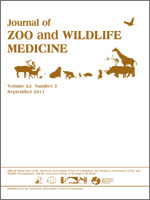Two adult female bontebok (Damaliscus pygarus dorcas) were euthanized because of signs of pneumonia and weakness (case 1), and a nonresponsive lameness with draining fistula (case 2). Necropsy findings were similar in both cases and consisted of disseminated granulomatous lesions in the liver, kidneys, spleen, lungs, pleural surfaces, and multiple lymph nodes. Mycobacterium kansasii was isolated from both cases after multiple attempts on a variety of samples by two laboratories. The remaining four animals in the herd were tested for antibody responses using the Chembio ElephantTB STAT-PAK®, DPP® VetTB kits, and multi-antigen print immunoassay (MAPIA), for immune reaction using the intradermal tuberculin test, and by tracheal wash cultures, and thoracic radiographs. Banked serum samples collected in 2005 and obtained from the original institution, revealed 1/9 (11.11%) seropositive animals using the three immunoassays. Retesting the current herd in 2008 showed 2/6 (33.33%) seropositive animals by the three tests, with MAPIA demonstrating antibody reactivity to MPB83 and MPB70 proteins. Inconsistent intradermal tuberculin test results, cross-reactivity in serologic assays designed for tuberculosis detection, difficulty in obtaining definitive identification by culture, and inability to identify a source of infection created challenges in distinguishing the atypical mycobacteriosis due to M. kansasii from the initially suspected tuberculous infection in this herd. Owing to regulatory considerations, differences in host-to-host transmission, and source of infection between Mycobacterium tuberculosis complex and nontuberculous mycobacteria, correct diagnosis is crucial for management of these diseases in wildlife species.
How to translate text using browser tools
1 September 2011
Mycobacterium kansasii Infection in a Bontebok (Damaliscus pygaragus dorcas) Herd: Diagnostic Challenges in Differentiating from the Mycobacterium tuberculosis Complex
Michele Miller,
Scott Terrell,
Konstantin Lyashchenko,
Rena Greenwald,
Beth Harris,
Bruce V Thomsen,
Deidre Fontenot,
Mark Stetter,
Don Neiffer,
Greg Fleming
ACCESS THE FULL ARTICLE
atypical mycobacteriosis
Bontebok
Damaliscus pygarus dorcas
immunoassay
Mycobacterium kansasii
serology





